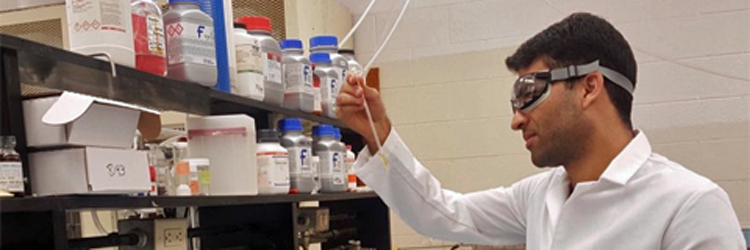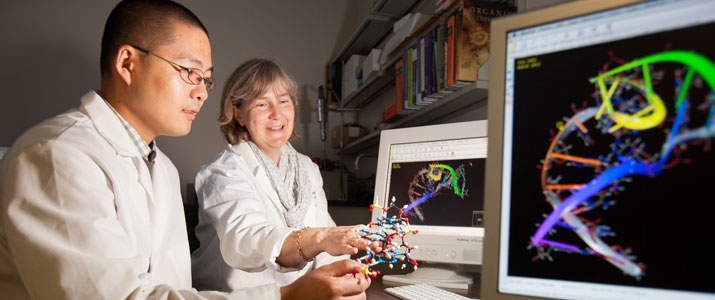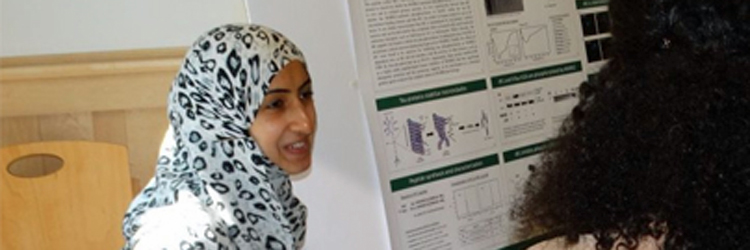Be Part of the Cure
Targeting Molecules in RNA Sequences
Mason Myers, a senior chemistry major in the Honors Tutorial College (HTC) and recently named Goldwater Scholar, has been researching ways on how to focus in on molecules in regards to antibiotic resistance research.
“When you are looking at finding a medical treatment, you want to make sure it hits the target that you want it to hit and nowhere else. Whether that is in the bacteria or the cells, you want to make sure it is very particular, that is to say high specificity,” Myers said.
Myers looks at small molecule-binding to the T-box riboswitch in order to find molecules that very accurately and strongly impact just that region of RNA.
Honey, I Shrunk the Cancer Killer?
When it comes to developing more effective therapeutics for cancer, doctoral student Ali Rafiei Miandashti emphasizes the key is to think small.
Rafiei, who works under the supervision of Chemistry & Biochemistry professor and Nanoscale and Quantum Phenomena Institute member Dr. Hugh Richardson, is studying a nanoscale technology that may one day be used in cancer treatment.
Traditionally, chemotherapy is used in conjunction with radiation therapy to combat the growth of cancerous cells. A fundamental flaw of this approach is that the treatment also damages healthy cells. Photothermal therapy, a novel approach that employs the use of tiny plasmonic nanoparticles to heat cells at the nanoscale, may help to overcome this limitation.
Flipping a Switch for Future Antibiotics?
Dr. Chunxi Zeng, awarded a Ph.D. in Chemistry in 2016, was the lead author on an article on "Factors that Influence T box Riboswitch Efficacy and tRNA Affinity" in Bioorganic and Medicinal Chemistry.
By researching methods of turning off the riboswitch, Zeng's research could lead to the development of a broad-spectrum antibiotic.
In the face of increasingly resistant bacterial strains, Zeng's work with the T box riboswitch provides hope that many life-threatening infections may be eradicated. Zeng notes that future antibiotics that target the riboswitch could potentially treat bacteria such as "methicillin-resistant staphylococcus aureus [MRSA], a notoriously hard-to-beat bacterium that is resistant to most current antibiotics," as well as pneumonia caused by a bacterium called Streptococcus pneumonia.
Zeng's research, funded by the National Institutes of Health, involves "finding completely new compounds targeted against an RNA switch that turns on or off the expression of essential proteins in bacteria," explains Dr. Jennifer Hines, who served as the article's Principle Investigator. "Chunxi developed an assay to monitor this RNA switch effectively, such that we could screen compound libraries to find a compound that would turn off the switch and kill the bacteria."
Solving of Piece of the Alzheimer’s Puzzle?
Doctoral chemistry student Najah Al Qaeisoom is working to understand one critical component of Alzheimer’s progression.
Working under the direction of Chemistry & Biochemistry Professor Justin Holub, Al Qaeisoom is synthesizing peptides that may inhibit a certain kinase that is known to play an important role in Alzheimer’s progression. She recently won third prize for her work in the graduate student competition at Neuroscience Research Day, and her work was published in the International Journal of Peptide Research and Therapeutics earlier this year.
Ultimately, Al Qaeisoom’s findings may help other researchers design treatments for Alzheimer’s patients to slow progression of this disease. However, she said, more research will be needed before this type of treatment can be used in clinical studies.



